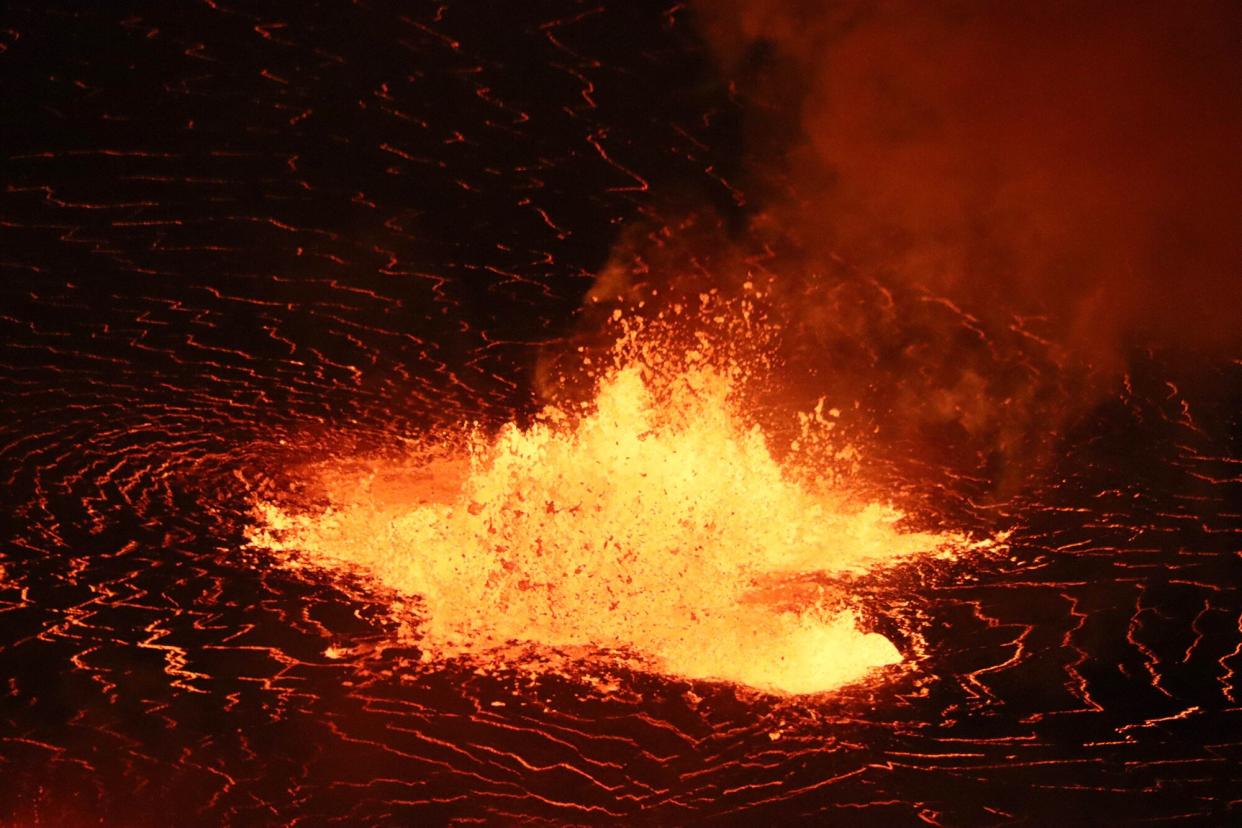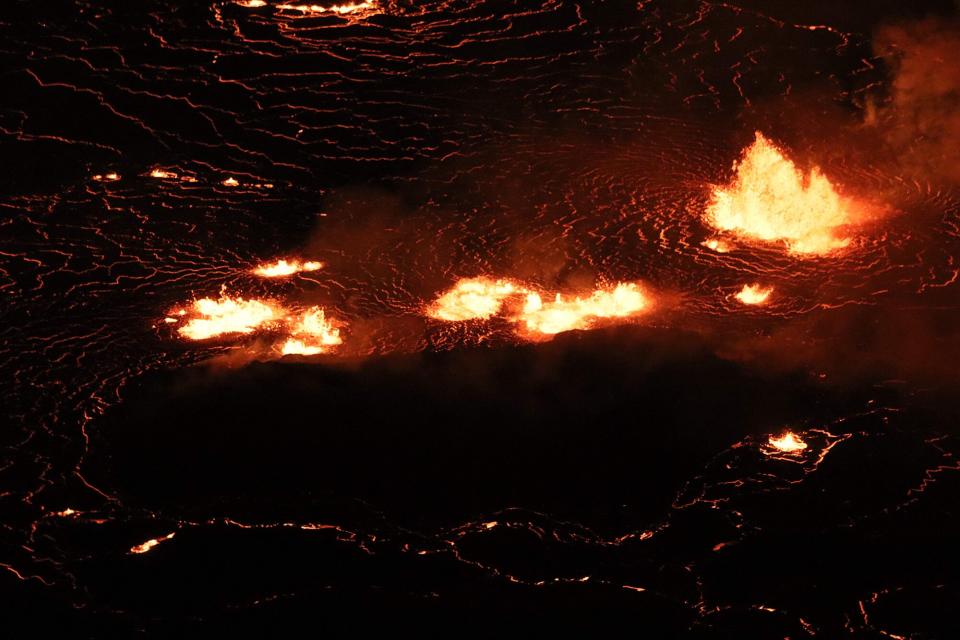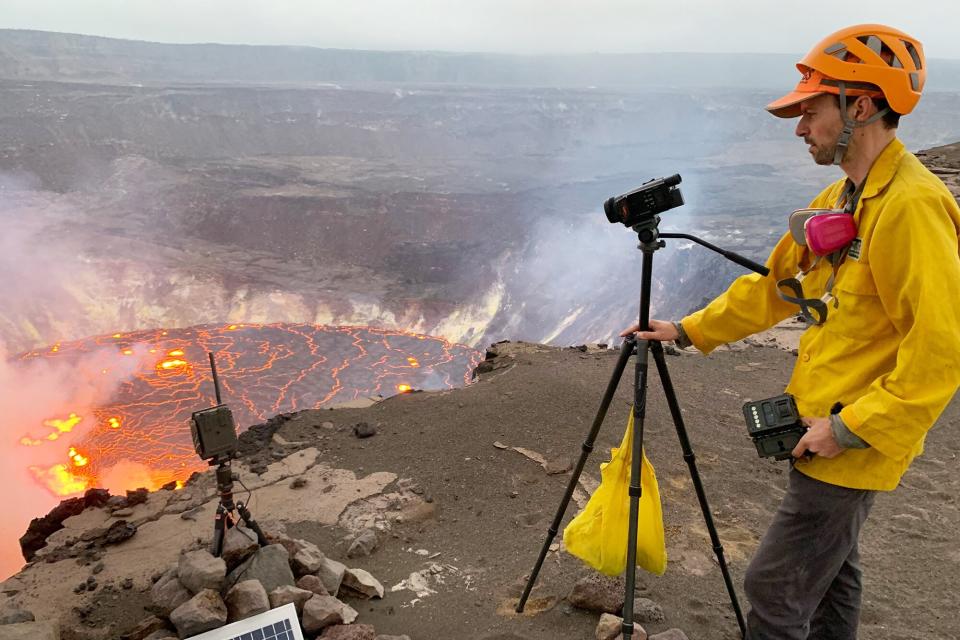Hawaii's Kilauea Volcano Erupts Again, Less Than a Year After Last Activity

M. PATRICK/US Geological Survey/AFP via Getty
Hawaii's Kilauea volcano is erupting for the second time in less than a year.
On Wednesday afternoon, the U.S. Geological Survey Hawaiian Volcano Observatory (USGS HVO) "detected glow in Kīlauea summit webcam images indicating that an eruption has commenced within Halemaʻumaʻu crater in Kīlauea's summit caldera, within Hawai'i Volcanoes National Park" per the County of Hawaii Hazard Impact Map. The seismic activity was detected around 3:20 p.m.,
Initial warnings were labeled with a code yellow and have since been upgraded to a code red "as this new eruption and associated hazards are evaluated," USGS HVO reported. The volcano has also upgraded the alert from "watch" to "warning."
Kīlauea’s eruption continues through the night! And where you find lava, you'll also find volcanologists making observations and collecting data. Activity is still confined to a crater that is within the closed area of Kīlauea’s summit. #KilaueaErupts #Kilauea pic.twitter.com/4taQXgpok4
— USGS Volcanoes🌋 (@USGSVolcanoes) September 30, 2021
RELATED: Kilauea Volcano Erupts on Hawaii's Big Island: 'Fallout Is Likely,' Officials Say
On Twitter, the organization revealed "The alert level had been at Yellow due to inflation of the volcano."
"It was clear that an intrusion or eruption would happen at some point, but until the magma starts to ascend, the exact timing is hard," officials said. "And you might only have minutes to a few hours once magma does start to rise."
In another tweet with "before" and "after" photos, the geological survey said, "#Kilauea #volcano summit #eruption is in full swing. What was once a cooling lava lake is now a new fissure eruption!"
Before..and..After! #Kilauea #volcano summit #eruption is in full swing. What was once a cooling lava lake is now a new fissure eruption! https://t.co/ZIxSFKk70V
Follow along with updates at the #HawaiianVolcanoObservatory website. #HVO https://t.co/KGKIwXB2A8#KilaueaErupts pic.twitter.com/jCqTFsJRMS— USGS Volcanoes🌋 (@USGSVolcanoes) September 30, 2021
RELATED: Homes Destroyed as Volcano Erupts in Spain's Canary Islands
"This new eruption at Kīlauea's summit is occurring within a closed area of Hawai'i Volcanoes National Park," officials said in the volcano report, noting that local residents are not at risk of injury.
In a tweet, USGS assured a resident, "The eruption is confined within a crater at Kīlauea's summit. Gas emissions will degrade air quality downwind, but lava activity is at the summit only."
"Residents should minimize exposure to these volcanic particles, which can cause skin and eye irritation," the USGS warned of the activity.
The organization had been monitoring the volcano on Hawaii's Big Island for a few months. Kilauea last had an eruption in December 2020, and the situation was not been contained until May 2021, USGS HVO revealed in their report.

M. PATRICK/US Geological Survey/AFP via Getty
At the time of the last eruption, the USGS shared several photos and videos to their Twitter feed, including a snapshot that showed "lava being cascaded into the summit water lake, boiling off the water and forming a new lava lake."
RELATED: Drone Captures Video of Destruction from Volcano's Lava on Canary Islands in Spain
"The northern fissure, pictured, was producing the tallest lava fountain at roughly 50 m (165 ft), and all lava was contained within Halema'uma'u crater in Kīlauea caldera," they continued.
In reply to one user who asked, "When was the last eruption inside the main crater?", the USGS responded, "There was an active lava lake within the crater during 2008-2018. It drained in response to the large lower East Rift Zone eruption in 2018. The last time there was an eruption like this one, with summit fissures, might have been 1982."
In 2018, Kilauea erupted as hundreds of earthquakes rattled the area for days, with magnitudes measuring 5.0 or higher, according to the Associated Press. The quakes were triggered after the Puu Oo crater floor began to collapse.
Never miss a story — sign up for PEOPLE's free weekly newsletter to get the biggest news of the week delivered to your inbox every Friday.
"The fissures are deadly, very deadly. We're currently in a condition red because of the increased ash in the area," Alan Richmond, spokesman for the Hawaii Police Department, told PEOPLE in May 2018. "We've had no injuries which is the good news."
"The danger is that there will be rocks and debris falling further down into the crater and when the lava hits the water table, there's an explosion," Richmond added at the time. "Everybody is on standby. It's a dicey situation and no one knows how long it will last and how it will end, just dealing with Mother Nature."
News of the latest eruption of Hawaii's Kilauea volcano comes nearly two weeks after lava in the Canary Islands in Spain destroyed hundreds of homes and displaced thousands of residents.

D. DOWNS/US Geological Survey/AFP via Getty
RELATED: Rachael Ray Reveals NYC Apartment Flooded During Hurricane Ida, a Year After Her House Burned Down
Several people questioned the USGS on Twitter about the perceived increased activity of volcanoes."
Global volcanic activity really isn't that unusual right now," the organization said, citing the Smithsonian Institution National Museum of Natural History's Global Volcanism Program. "There are always 40-50 volcanoes erupting at any give time! It seems like its elevated, but that's really due to a coverage bias."

